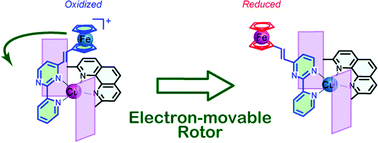Synchronized motion and electron transfer of a redox-active rotor†
Abstract
We have constructed a series of copper complexes with asymmetric 4,6-substituted 2-pyrimidyl coordination units, which form two coordination isomers via rotation of the pyrimidine ring. Redox-active ferrocenyl moieties were introduced at the 4-positions of the

- This article is part of the themed collection: New Talent: Asia

 Please wait while we load your content...
Please wait while we load your content...